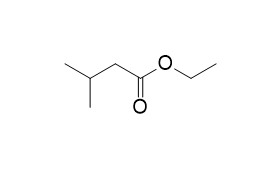Ethyl isovalerate
Ethyl isovalerate is a aroma contributor in wine.
Inquire / Order:
manager@chemfaces.com
Technical Inquiries:
service@chemfaces.com
Tel:
+86-27-84237783
Fax:
+86-27-84254680
Address:
1 Building, No. 83, CheCheng Rd., Wuhan Economic and Technological Development Zone, Wuhan, Hubei 430056, PRC
Providing storage is as stated on the product vial and the vial is kept tightly sealed, the product can be stored for up to
24 months(2-8C).
Wherever possible, you should prepare and use solutions on the same day. However, if you need to make up stock solutions in advance, we recommend that you store the solution as aliquots in tightly sealed vials at -20C. Generally, these will be useable for up to two weeks. Before use, and prior to opening the vial we recommend that you allow your product to equilibrate to room temperature for at least 1 hour.
Need more advice on solubility, usage and handling? Please email to: service@chemfaces.com
The packaging of the product may have turned upside down during transportation, resulting in the natural compounds adhering to the neck or cap of the vial. take the vial out of its packaging and gently shake to let the compounds fall to the bottom of the vial. for liquid products, centrifuge at 200-500 RPM to gather the liquid at the bottom of the vial. try to avoid loss or contamination during handling.
Indian J Pharm Sci.2022, 84(4): 874-882.
Industrial Crops and Products2017, 95:286-295
J Cell Mol Med.2023, jcmm.18071.
Phytochemistry.2021, 181:112539.
Front Neurosci.2019, 13:1091
J Tradit Chin Med.2023, 43(6):1081-1091.
Agronomy2022, 12(10), 2426.
Br J Pharmacol.2024, 181(24):5009-5027.
Korean J. of Horticultural Sci. & Tech. 2017, 793-804
Life Sci.2022, 311(Pt A):121157.
Related and Featured Products
2000, 80(11):1659-1667.
Quantitative determination of the odorants of young red wines from different grape varieties.[Reference:
WebLink]
METHODS AND RESULTS:
Fifty-two young monovarietal red wines made with Grenache (17 samples), Tempranillo (11 samples), Cabernet Sauvignon (12 samples) and Merlot (12 samples) grapes have been analysed by HRGC–MS to obtain quantitative data on 47 odorants previously identified as potential aroma contributors by olfactometric techniques. Thirty-three odorants were present in the wines at concentrations higher than their corresponding odour thresholds. These include ethyl octanoate, β-damascenone, ethyl hexanoate, isovaleric acid and isoamyl acetate as the most important, which together with isoamyl and β-phenylethyl alcohols, fatty acids, 2,3-butanedione and ethyl butyrate are always found at concentrations higher than their odour thresholds. In some cases the ethyl esters of isobutyric and isovaleric acids, β-ionone, methionol, isobutyric acid, ethyl cinnamate, ethyl dihydrocinnamate, γ-nonalactone, eugenol, c-3-hexanol, geraniol, guaiacol, 3-isobutyl-2-methoxypyrazine, 4-ethylguaiacol, acetoin and t-whiskylactone were at a concentration high enough to be odour-active.
CONCLUSIONS:
There were 30 compounds that were found to differ significantly between varieties. These include 3-isobutyl-2-methoxypyrazine, isoamyl acetate, isovaleric acid, ethyl isobutyrate, Ethyl isovalerate, fusel alcohols, c-3-hexenol, methionol, eugenol, guaiacol and γ-nonalactone.



